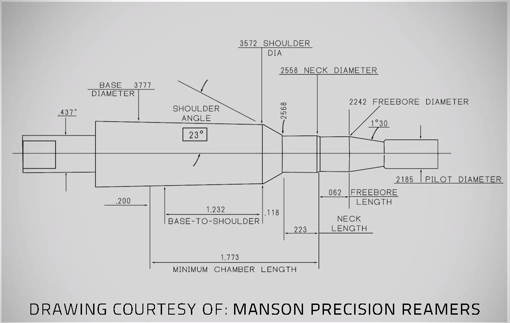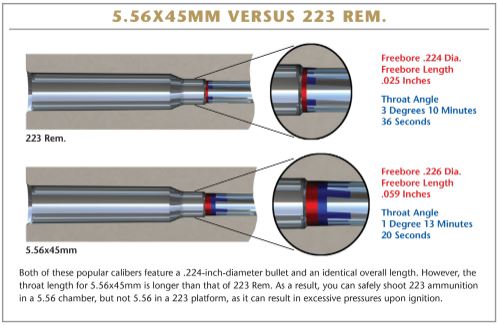.223 Wylde (Chamber)
The .223 Wylde chamber was designed by Bill Wylde (a gunsmith from Greenup, Illinois). The intent was to keep the potential accuracy benefits of a .223 chamber, and also the better ammunition selection of being able to fire 5.56 loadings. All while safely avoiding excessive pressure buildup that results when firing higher-pressure 5.56mm NATO ammunition in a normal .223 Remington chamber. In other words, this is a hybrid chamber that seeks to gain the best of both worlds.
As a result, guns with a .223 Wylde chamber are typically safe for either .223 or 5.56 ammunition, and in theory, should produce better accuracy across the board, regardless of ammunition choice. It has become relatively popular, especially among competition shooters, or those who simply want to enjoy the "best of both worlds" features of a .223 Wylde chamber.
Note: While ".223 Wylde" sounds like it may be referring to a type of ammunition, it is actually just referring to a type of chamber, or perhaps more accurately, the dimensions of said chamber.
What is .223 Wylde?
To understand the rationale behind the .223 Wylde chamber, one must first understand the differences between .223 Remington and 5.56x45mm NATO. Despite some common misconceptions, these two cartridges are actually identical in dimensions. The difference is that 5.56 NATO ammunition is loaded to higher pressures. To allow for the extra pressure, a 5.56 chamber has a longer (and wider) throat. And so of course as a result, firing the already lower pressure .223 in a 5.56 chamber is completely safe. However, the opposite is not necessarily true. Because a .223 chamber (or rather the chamber throat) is not designed to handle the added pressure of 5.56, this can lead to excess pressures, potentially resulting in catastrophic failure of the firearm and/or injury to the user. There is much debate on how true this may or may not be, but the danger is best avoided in the first place.
The problem is that although a chamber rated for 5.56x45mm NATO will properly shoot both types of loadings, it has one issue, especially when talking about precision accuracy. Because of the longer, wider throat, there is a greater distance that the bullet needs to "jump" between its starting position inside the casing, to the beginning of the barrel's rifling. Likewise, that gap is wider, leading to a "looser" chamber/throat. This theoretically decreases accuracy potential.
Bill Wylde's ".223 Wylde" chamber, tries to bridge the gap and obtain the best of both world. It features a chamber throat that is shorter than the 5.56 chamber throat, and only slightly wider than a .223 chamber. Basically, Bill Wylde improved these aspects of the chamber as much as possible, while still allowing for higher-pressured 5.56 NATO ammunition. The results are better theoretical accuracy of the shorter and narrower-throated .223 Remington chamber, and the larger ammunition selection that comes with 5.56 loadings, leading to an all-around more accurate chamber that is still rated to safely fire both types of ammunition.
Manufacturers
There are a number of major manufacturers that sell rifles featuring a .223 Wylde chamber, including (but definitely not limited to):
And many others. Alternatively, one could also modify their current AR-15 by simply installing a new barrel w/ .223 Wylde chamber, currently being produced by many barrel manufacturers.
Video Explanation
Brownells also uploaded a great YouTube video explaining .223 Wylde.
<youtube>Ya2JqLPyx4I</youtube>

